"They must be Chinese works!" This is likely your first thought upon a quick and casual glance at the two below paintings, which are marked by bright colors and vibrating with a vivaciously rural style and bold imaginations. The brush strokes are absolutely Chinese. Or more specific, they are Chinese peasant or Chinese folk paintings. The unique brushwork is highly regarded throughout the world for its theory, expression, and techniques.
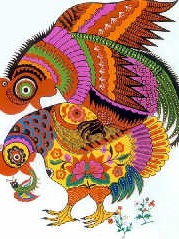
Just as the name implies, Chinese Peasant paintings are created by Chinese farmers or peasant artists. Their compositions are linked with the daily life in rural areas, covering farm work and animals, festivals, music, village customs, harvest scenes, and children. Theses subjects completely free themselves from staleness and are always painted in grand fashion. The style can be described as primitive, with childlike figures, vivid colors, and exaggerated forms that are far beyond the common world of most people. A case in point is the contour of the chickens and the worm in the first picture.
Both the hen and the rooster, gorgeously designed, easily arouse the image of the legendary phoenix, especially with the hen supported by its two legs, each as strong as the hind legs of the larger rooster.
The rooster, standing on the back of the hen, looks like a bird since its green feather is so brilliantly decorated. The lively worm, on the other hand, stares at its predator the hen with no signs of dread although it is insignificant in terms of size.
The incident of the chicken and the worm goes beyond what the villagers see in daily life and the striking contrast highlights the artistic technique of exaggeration. Besides, the painting is closely related to the Chinese traditional arts of embroidering, batik (a kind of coloring method),paper cutting, and wall painting.
The above brushworks bear the distinctive quality inpapercuts that are signs of good fortune and are pasted on house and restaurant windows. Chicken and fish serve as the common subjects of Chinese folk art in that the Chinese words of ji and yu sound like the term for auspiciousness and plenty respectively.
Moreover, The rural elegance that comes with peasant paintings spreads out the smell of vegetations in thewildernessas compared with the urban life -- noise of business. This feature helps give Chinese peasant paintings their edge and accounts for the folk art attracting more favorable attention in recent years.Chinese peasant painting, as an art genre, first emerged in the 1950s and took shape in the 1970s. After decades of development, it demonstrates strong momentum as quite a few counties are titled "Painting Villages" nationwide. The famed folk painting centers are Huxian, Ansai, Longmen, Wuyang, and Xinji. Now let's look at this traditional brushwork in detail.
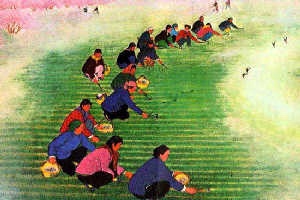
Huxian is located 38 kilometers southwest ofXi'anCity (In North China'sShaanxi Province), the ancient capital renowned by the cultural heritage of the Qin-Dynasty (221-206BC)terracotta warriors, the old city wall, and thedrum tower. Picturesque in nature, the local people in Huxian have kept up the fine tradition of drawing the dynamic scenes of their daily life. Due to their outstanding achievements in developing this folk art since 1950s, the stateMinistry of Culturein 1988 awarded the region the honorary title of "a Village of Chinese Modern Folk Painting," Huxian paintings feature notable regional tones, marked by pictorial landscape and the rustic life.
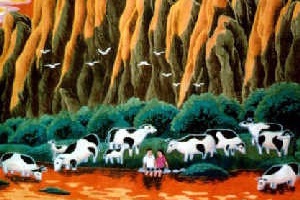
The above painting "Herding" by the peasant artist Liu Zhigui expresses the way people are leading a simple and free life in harmony with nature. The herders are encircled by the serene cows, which seem to be enjoying the luxuriant grass and appreciating fresh air. The sunset dyes the water with red colors that are associated with vigorous life and bumper harvest. The painting well combines the traditional theme of simplicity and the modern spirit of freedom, hence possessing a high value for academic research and collections.
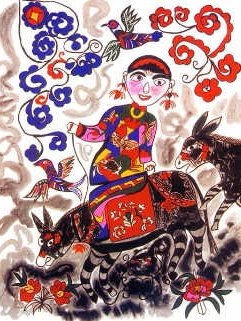
Ansai paintings, mainly created by female farmers after the completion of farm chores, have received raving reviews by people and are stamped as "the Ancient Picasso".
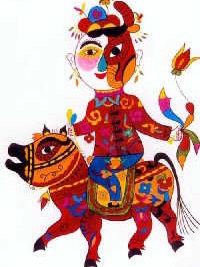
The Ansai painting to the left is characterized by fancy imaginations and bold colors. Its exaggerated modeling, distortion, and surrealistic style lend a feeling of truthfulness and naivety. The flamboyant color and compositions are imaginative, and cheerfully decorative. The art possesses the simplicity of people.
Some of the Ansai farmers' paintings are collected in the National Art Museum of China. What's more, the local brushworks have been exhibited in "the French Independent Salon Arts," while newspapers and periodicals like Arts, China Pictorial, and People Daily have appraised the folk art as a whole. In 1998, Ansai County won the title of "a Chinese Peasant Painting Village" by the State Ministry of Culture.
Longmen paintings stand out for their strong influence in the style from southern ethnic nationalities, an attribute that is rare in Chinese Native Art. With more attention now shifted to the study of ethnography, Longmen folk art has gradually attracted its due attention. More than 100 pieces of Longmen works have been displayed both at home and abroad, of which 48 paintings have been awarded provincial-level prizes. Besides, foreigners have bought over 4,500 brushworks.
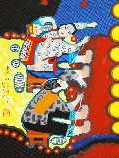

Sharing the common traits of the rural pastures and gleeful atmosphere characterized by Chinese peasant paintings, Wuyang folk paintings are featured by the geometrical patterns designed in their brushwork. The painting "Off the Sunning Ground" (to the right) gives an example of such style. The ground is covered by drying-grains in the shape of several concentric circles as a farmer is leading two cows on the ground. In the sun, the grains are shining in golden circles, which gives prominence to the theme of harvest. Outside the sunning ground are a number of farmers who are busy with farm work and help add dynamic flavor to the charming seasons. The pattern of circles lends aesthetic symmetry to the vigorous scenes. Besides, circles in Chinese symbolize consummate or perfect condition.
It is not desirable to exhaust a complete picture of any country's folk culture. In addition, words can never be a close match to the actual works. Therefore it is a pity for a traveler to China to miss the rich treasury of folk culture. After all, in a country where farmers account for 70 percent of the nation's total population, the essence of folk culture lies in Chinese peasant arts.



